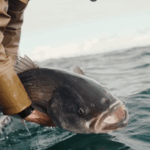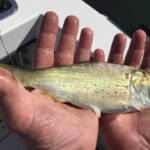
No, Striped Bass Are Not “Back” in North Carolina
This week, an Axios Raleigh article made the rounds claiming there may have been a
By Tony Friedrich, Vice President and Policy Director
The Atlantic States Marine Fisheries Commission (ASMFC) will hold the next Striped Bass Management Board meeting on Oct 20, 2021. This is where the rubber meets the road. Amendment 7 will most likely be accepted for public comment. Once that happens, we will have a finite window to comment. Every single individual is needed. If you love these fish, you better take the time to send your thoughts in during the comment period, most likely between November and December 2021. We will let you know when the hearing dates, the exact time frame for emails and letters, and, of course, our priorities and preferred actions.
As we mentioned on social media posts over the past few weeks, the ASGA team has listened in on the striped bass Plan Development Team (PDT) virtual meetings. There were several bright spots in the meetings. There are also some things to be concerned about. Let’s look at what happened and this time, we will start with the good stuff.
Protecting the 2015 Year Class
Why is this important? People love to say that there is no biomass/recruitment relationship with striped bass. That is, the number of fertile females doesn’t impact the success of the spawn, and indeed, rainy, wet springs are the main driver for spawning success. However, there are two items to consider here. First, if the Spawning Stock Biomass falls below a certain level, there is a relationship between the two items, with lower recruitment when there are fewer spawners in the system. Second, the strategy that worked during the moratorium was protecting the 1982-year class. This was done in 1985 and drove the recovery with the prolific spawns of the late 1990s and early 2000s, as you can see in the below chart of striped bass recruitment in the Maryland portion of Chesapeake Bay:
![]()

The ASGA position of 1 fish at 35” during the Addendum VI process was based on this logic. Our effort failed and the pseudo-slot limit (28”-35”) was introduced. We say “pseudo” because through conservation equivalency, some states sidestepped the slot limit and were still allowed to kill large fish. How does a slot limit work for a coastal migratory stock if everyone doesn’t have to abide by the same rules?
Now, we are looking down the barrel of the strong 2015 year class being in or getting close to the slot size. It is imperative that we do everything we can to ensure that this cohort is allowed to spawn a few times before they can be harvested. Nothing is a silver bullet, but this is pretty darn close.
Conservation Equivalency (CE)
CE has been a huge obstacle in the recovery of striped bass. As you likely know by now, it is a way for states to get around coastwide regulations by allowing jurisdictions the “flexibility” to design their own season, size, and bag limits.
The upside of the controversy surrounding CE is that managers are discussing ways to frontload accountability into these proposals. What does that mean? If a jurisdiction wants to use CE, the CE plan would have to be more conservative (more likely to achieve the management goal) than the approved coastwide measure. How much more conservative is yet to be determined.
![]()
![]()
![]()
![]()
Our big question: How do we expect to accomplish the goal of protecting the 2015 year class if we allow CE into the discussion even with extra front-end measures? Our current slot is supposed to protect big fish over 35” right? But, Maryland still had a trophy season last year due to their CE proposal which was reviewed and accepted by the Technical Committee. Are we going to allow this to happen to the 2015 year class even when one of the goals of Amendment 7 is to protect that year class? CE is a problem and will continue to be something that will inhibit striped bass recovery.
Catch and Release Mortality
We have said time and time again that this is a huge red herring. The Massachusetts Division of Marine Fisheries is in the middle of groundbreaking research on catch and release mortality of striped bass. The scientist are doing good work. The scope of the work will provide information on all ranges of fishing and uses acoustic tags rather than monitoring caught fish in a net pen or salt pond. This research will set the stage for the next decade of our understanding of catch and release fishing for striped bass. The fact that we didn’t put the brakes on this element of Amendment 7 until this research’s results come out should be a red flag to everyone. The new science will give us the information we desperately need to make the best decisions possible for the stock. Moving forward without such information is just dishonest.
The main talking point of the supporters of this action is that catch and release mortality is a leading driver in overall mortality in striped bass. Well, that kind of makes sense when you realize that recreational anglers have released around 90% of fish annually for the past 30-plus years (see chart below). That trend has not been impacted by changes in the stock, size limits, or creel limits. Anglers choose to release striped bass. That is the social dynamic of the fishery. Release mortality numbers will also be one of the leading causes of mortality. Placing the blame of the decline of the stock on catch and release anglers is disingenuous at best and an outright lie and deflection at worst.

Here’s a question for you. If the percentage of fish released has been constant for three decades, why is it such an issue now? Right… because the stock is in serious decline and the folks who don’t want to take any reductions are looking for a scapegoat.
Management Triggers
This issue gives us the greatest cause for concern. Striped bass management triggers are management tools that are supposed to call for action for stock decline, poor recruitment, or overfishing. There are five management triggers for striped bass. You can review them here.
All the proposals for adjusting triggers can be summed up easily: If the timelines are extended, striped bass and the fishery both lose. Let’s use Management Trigger 1 as an example.
Management Trigger 1:
If the Management Board determines that the fishing mortality threshold is exceeded in any year, the Board must adjust the striped bass management program to reduce the fishing mortality rate to a level that is at or below the target within one year.
One of the proposals on the table would change the timeline to three years. So, striped bass would have to be overfished for three years in a row for there to be any adjustments to the rate of harvest. In normal people terms, that means the stock gets hammered for three years instead of one.
This shouldn’t come as a shock because the direction from the workgroup that began the Amendment 7 process was for management stability. Now, you may read that and think, that sounds good. It isn’t. This version of “stability” is not for the health of the stock but in the regulations. It has been said that recreational fishermen desire the same regulations year after year. Somehow, somewhere along the line, this lie has been told enough that some believe it. Look, I have been working in fisheries for decades. Never once in my life has a fisherman come up to me and said, “The size and creel limits change too often. I wish they were the same every year.” Yet this “workgroup,” headed up by the exact same individuals who are pushing for “stability” through the harvest control rule effort for other Mid-Atlantic species, are pushing the same lie for striped bass.
It is completely disingenuous to not include the word “regulatory” in front of “stability” when sending out these documents. Fishermen who want to comment but don’t do this every day associate stability with something good, not something that could do real damage to a fishery.
What’s Next?
We beat back some of the worst potential parts of the amendment during the Public Information Document process earlier this year. So, give yourself a big pat on the back. Amendment 7 will be a better document than we originally thought but make no mistake, there are still landmines all over the place. We are a little less than a month out from getting the final version of Amendment 7. We know this is prime time for fishing. You have to find the time to participate. We’ll tell you when, where, and how.

This week, an Axios Raleigh article made the rounds claiming there may have been a

Feature Photo Credit: Robbie Tartaglia What’s going on? For decades, striped bass management relied on a

Recent developments in the 2025 Atlantic Menhaden Stock Assessment Update, released by the Atlantic States

What’s going on? The “most important fish in the sea” just exposed one of the
We rely on our members and donations to keep fighting for a sustainable tomorrow in marine conservation.
GIVE THE GIFT OF FISHERIES CONSERVATION THIS HOLIDAY SEASON. SHOP ASGA GOODS THAT FUND FISHERIES RESEARCH & ADVOCACY CAMPAIGNS
JOIN ASGA IN CALLING FOR CRITICAL MANAGEMENT ACTION AFTER YEARS OF SPAWN FAILURES & POOR MANAGEMENT.
By using this website, you agree to our use of cookies. We use cookies to provide you with a great experience and to help our website run effectively. To learn more, please review our privacy policy.
7 Responses
Keep up the good work!
Total Moratorium is necessary
Oof
Nothing makes sense but to error on the side on conservation
Man.. We LOVE this comment!
Thank you for the information and your hard work. I will be sure to send in my comments when the time comes.
I am hoping more conservation minded restrictions come out of this. I am sick and tired of the horrendous fishing I have experienced in my home water for the past several years now.